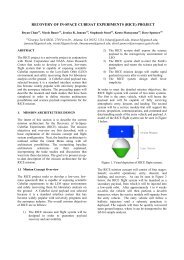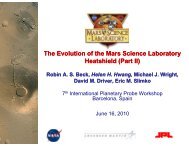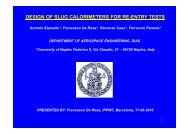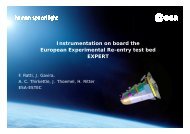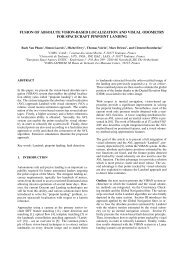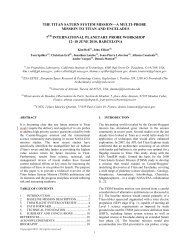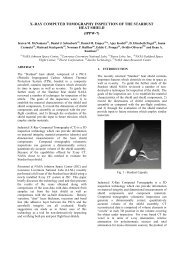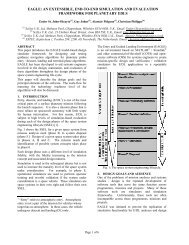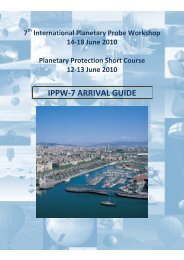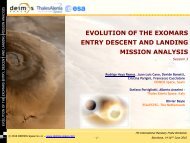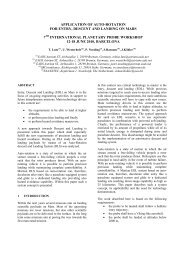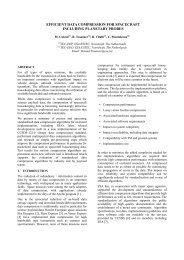stagnation-point radiative heat fluxes in neptune aerocapture
stagnation-point radiative heat fluxes in neptune aerocapture
stagnation-point radiative heat fluxes in neptune aerocapture
Create successful ePaper yourself
Turn your PDF publications into a flip-book with our unique Google optimized e-Paper software.
STAGNATION-POINT RADIATIVE HEAT FLUXES IN NEPTUNE AEROCAPTURE<br />
Chul Park<br />
Department of Aerospace Eng<strong>in</strong>eer<strong>in</strong>g, Korea Advanced Institute of Science and Technology<br />
373-1 Guseong-dong,Yuseong-gu, Daejeon, 305-701, South Korea, cpark216@kaist.ac.kr<br />
ABSTRACT<br />
The <strong>radiative</strong> <strong>heat</strong> flux <strong>in</strong>cident on the edge of the<br />
boundary layer at the <strong>stagnation</strong> <strong>po<strong>in</strong>t</strong> of a spacecraft<br />
enter<strong>in</strong>g <strong>in</strong>to Neptune is calculated approximately. The<br />
atmosphere of Neptune is assumed to consist of a<br />
81%H 2 -19%He mixture. The flow along the <strong>stagnation</strong><br />
streaml<strong>in</strong>e is represented by a one-dimensional <strong>in</strong>viscid<br />
flow <strong>in</strong> a constant-area channel. A technique recently<br />
developed by the author is applied to determ<strong>in</strong>e the<br />
<strong>radiative</strong> <strong>heat</strong> flux reach<strong>in</strong>g the end of a 1 cm gas slug<br />
<strong>in</strong> this constant-area tube. A blunted double cone entry<br />
vehicle of L/D = 0.88 with a nose radius of 0.2 m and<br />
ballistic coefficient of 609 kg/m 2 is assumed to fly an<br />
aero-brak<strong>in</strong>g trajectory <strong>in</strong> retrograde direction. Entry<br />
velocities of 31, 29, 27, and 25 km/s are calculated to<br />
produce <strong>radiative</strong> <strong>heat</strong> loads of 84, 172, 49, and 22<br />
kJ/cm 2 .<br />
1. INTRODUCTION<br />
Humans have succeeded <strong>in</strong> enter<strong>in</strong>g the atmosphere of<br />
the planet Jupiter <strong>in</strong> the Galileo Probe mission. But the<br />
other outer planets, Saturn, Uranus, and Neptune, are<br />
yet to be explored. Of these, Neptune has drawn some<br />
<strong>in</strong>terest already [1,2]. In Neptune entry, Ref. [1] shows<br />
that the peak <strong>heat</strong><strong>in</strong>g occurs when the <strong>stagnation</strong><br />
pressure is about 1 atm. The shock layer flow is likely<br />
to be <strong>in</strong> a thermochemical nonequilibrium state.<br />
Neptune's atmosphere consists of 81% H 2 , about 18%<br />
He, and a small concentration of other gases, mostly<br />
CH 4 [3]. The anticipated entry velocities vary up to<br />
about 30 km/s. In Ref. [1], the nonequilibrium flow<br />
conditions were calculated us<strong>in</strong>g a chemistry model<br />
derived from the <strong>in</strong>formation generated prior to 1990.<br />
The most crucial part of the chemistry model used <strong>in</strong><br />
Ref. [1] concerns ionization rate of atomic hydrogen.<br />
The model is from the shock tube experiment of<br />
Leibowitz [4] of 1973. In 1976, Liv<strong>in</strong>gston and Poon<br />
[5] carried out another shock tube experiment. Both<br />
these experiments measured the time needed to reach<br />
ionization equilibrium <strong>in</strong> hydrogen. There was up to a<br />
factor three difference <strong>in</strong> the ionization times<br />
determ<strong>in</strong>ed by these two groups: Liv<strong>in</strong>gston and<br />
Poon’s times were longer. In Liv<strong>in</strong>gston and Poon’s<br />
work, absolute value of the peak electron density was<br />
measured. Surpris<strong>in</strong>gly, the measured electron density<br />
was higher than the equilibrium value.<br />
Howe [6] reasoned that H should ionize mostly by the<br />
collisions of electrons. Because one electron-impact<br />
ionization produces one additional electron, this<br />
process <strong>in</strong>creases ionization level exponentially.<br />
Therefore the ionization should occur suddenly, <strong>in</strong> a<br />
process known as avalanche ionization. Howe believed<br />
that significant radiation occurs only when H-atoms are<br />
ionized. And so, <strong>in</strong> the region upstream of this<br />
avalanche ionization, radiation emission should be<br />
nearly zero. Avalanche ionization drives the chemical<br />
state to ionization equilibrium, and so the region<br />
downstream of ionization will emit equilibrium<br />
radiation. This reason<strong>in</strong>g leads to the conclusion that<br />
the delay of ionization due to nonequilibrium generally<br />
reduces the <strong>radiative</strong> <strong>heat</strong> transfer rate to an entry<br />
vehicle.<br />
Very recently, Park [7] analyzed both Leibowitz’s and<br />
Liv<strong>in</strong>gston and Poon’s experimental data. Park<br />
concluded that the data of Leibowitz may have been <strong>in</strong><br />
error. The error was likely caused by the <strong>in</strong>fluence of<br />
the radiation emitted by the driver gas absorbed by the<br />
test gas. From the work of Liv<strong>in</strong>gston and Poon, Park<br />
derived a comprehensive thermochemical model for<br />
ionization of hydrogen-helium mixtures. Park’s model<br />
reproduces both experimental data, and enables one to<br />
calculate radiation <strong>in</strong>tensity <strong>in</strong> a hydrogen-helium<br />
mixture under a nonequilibrium condition. Park then<br />
applied this model to one entry trajectory considered<br />
by Jits et al.<br />
It is the purpose of the present work to apply Park’s<br />
method to a wider range of Neptune entry conditions.<br />
2. PARK’S MODEL<br />
From the exist<strong>in</strong>g experimental and theoretical data,<br />
Park [7] reasoned that the temperature of electrons and<br />
the vibrational temperature of H 2 will be strongly<br />
coupled. The latest work by Kim et al [8,9] show that,<br />
dur<strong>in</strong>g the dissociation of H 2 by the collisions of H, H 2 ,<br />
and He, rotational temperature is not <strong>in</strong> equilibrium<br />
with the translational temperature. However, a twotemperature<br />
description is still valid <strong>in</strong> describ<strong>in</strong>g the<br />
process of dissociation of H 2 provided the rate
coefficients are properly chosen. Thus, a twotemperature<br />
model can be derived <strong>in</strong> which vibrational,<br />
electron, and electronic temperature is one temperature<br />
and translational temperature is another temperature.<br />
equilibration distance was reproduced. In Fig. 3, the<br />
<strong>in</strong>fluence of the driver irradiation is shown.<br />
In the work of Park [7], these latest works of Kim et al<br />
[8,9] were used <strong>in</strong> describ<strong>in</strong>g the process of<br />
dissociation of H 2 <strong>in</strong> the presence of H, H 2 , and He.<br />
Ionization of H is considered to occur by the collisions<br />
of electrons, H, and He. Eight rate coefficients were<br />
derived to describe the ionization <strong>in</strong> this situation,<br />
which are functions of the heavy particle temperature,<br />
vibrational-electron-electronic temperature, number<br />
density of H and He, and the extent of absorption of<br />
radiation by the Lyman- l<strong>in</strong>e of H at 1216 A [10]. The<br />
extent of absorption of Lyman-a l<strong>in</strong>e was calculated <strong>in</strong><br />
turn by <strong>in</strong>tegrat<strong>in</strong>g the <strong>radiative</strong> transfer equation<br />
through the entire medium <strong>in</strong>clud<strong>in</strong>g the freestream.<br />
The crucial unknown parameter <strong>in</strong> describ<strong>in</strong>g the<br />
ionization process <strong>in</strong> a H 2 -He mixture is the cross<br />
section for excitation of H by the collisions of H and<br />
He. Leibowitz [4] determ<strong>in</strong>ed the cross section to be 4<br />
x 10 -17 cm 2 from his experiment.<br />
Fig. 1. Equilibration distance <strong>in</strong> the experiment by<br />
Liv<strong>in</strong>gston and Poon [5].<br />
In 2002, Bogdanoff and Park [11] carried out an<br />
experiment <strong>in</strong> a shock tube similar to that used by<br />
Leibowitz [4]. They saw that ionization equilibration<br />
occurred much earlier than predicted by Leibowitz’s<br />
model and the level of ionization was much larger than<br />
the equilibrium value. By analyz<strong>in</strong>g the radiation<br />
travell<strong>in</strong>g along the shock tube, they found that the<br />
radiation emitted by the hot driver gas was responsible<br />
for this phenomenon.<br />
The shock tube used by Bogdanoff and Park [11] and<br />
that by Leibowitz [4] were both driven by an electricarc<br />
<strong>heat</strong>ed driver gas. In the latest work of Park [7],<br />
Leibowitz’s data is not used <strong>in</strong> deduc<strong>in</strong>g the cross<br />
section. Instead, the results by Liv<strong>in</strong>gston and Poon [5]<br />
were used. Liv<strong>in</strong>gston and Poon used a shock tube<br />
which was driven by a magneto-hydrodynamic force.<br />
As such, strong irradiation by the drive gas was not<br />
likely.<br />
From the data of Liv<strong>in</strong>gston and Poon, the ionization<br />
cross section of H and He was deduced by Park [7] to<br />
be 1 x 10 -17 cm 2 . Fig. 1 compares the experimental data<br />
of Liv<strong>in</strong>gston and Poon with Park’s model. The peak<br />
electron density values calculated by Park are<br />
compared with experimental data <strong>in</strong> Fig. 2. As seen,<br />
fairly good agreement was obta<strong>in</strong>ed.<br />
In order to numerically reproduce the experimental<br />
data by Leibowitz [4], Park assumed that the driver gas<br />
was irradiat<strong>in</strong>g as a black body. The assumed driver<br />
temperature was varied until the measured<br />
Fig. 2. Peak electron density <strong>in</strong> the experiment by<br />
Liv<strong>in</strong>gston and Poon [5].<br />
By choos<strong>in</strong>g the driver temperature appropriately, the<br />
experimental data on the variation <strong>in</strong> cont<strong>in</strong>uum<br />
radiation <strong>in</strong>tensity obta<strong>in</strong>ed by Leibowitz can be<br />
reproduced, as shown <strong>in</strong> Fig. 4. The equilibration<br />
distance obta<strong>in</strong>ed by Leibowitz can be reproduced also<br />
by choos<strong>in</strong>g appropriate values of driver temperature<br />
as shown <strong>in</strong> Fig. 5.<br />
2
In Fig. 5, one sees a factor of three difference <strong>in</strong><br />
equilibration distances between that with driver<br />
radiation and that without. Thus the difference between<br />
the two sets of data is now reconciled by account<strong>in</strong>g<br />
for the driver irradiation. The ionization cross section<br />
value of 4 x 10 -17 cm 2 obta<strong>in</strong>ed by Leibowitz, four<br />
times larger than the 1 x 10 -17 cm 2 obta<strong>in</strong>ed by Park [7],<br />
reflects this factor three higher equilibration rate.<br />
Fig. 3. Effect of driver irradiation on ionization level<br />
and equilibration distance.<br />
As Fig. 4 shows, ionization of H is rather gradual and<br />
does not occur <strong>in</strong> an avalanche fashion. As will be<br />
shown later, radiation occurs not only <strong>in</strong> the<br />
downstream region where ionization level is high but<br />
also <strong>in</strong> the upstream region where ionization level is<br />
low. This phenomenon <strong>in</strong>validates the theory of Howe<br />
[6].<br />
3. METHOD OF CALCULATION<br />
Jits et al considered a blunted double cone fly<strong>in</strong>g <strong>in</strong><br />
Neptune to aero-brake the vehicle so that it is <strong>in</strong>serted<br />
<strong>in</strong>to an elliptic orbit that approaches Neptune’s moon<br />
Triton. The entry flight occurs <strong>in</strong> the retrograde<br />
direction because Triton’s orbital motion is retrograde<br />
with respect to the rotation of Neptune. The vehicle has<br />
a mass of 600 kg, base diameter of 1 m, and a ballistic<br />
coefficient of 609 kg/m 2 . The vehicle performs a<br />
sophisticated roll modulation to m<strong>in</strong>imize <strong>heat</strong> load.<br />
Table 1 summarizes the convective and <strong>radiative</strong> <strong>heat</strong><br />
loads calculated by Park [7] for this trajectory.<br />
Fig. 4. Variation of cont<strong>in</strong>uum radiation <strong>in</strong>tensity<br />
obta<strong>in</strong>ed by Leibowitz [4] and Park’s calculation.<br />
Table 1. Flight environments of Jits et al (2003)<br />
trajectory.<br />
Flight<br />
time<br />
sec<br />
Freestrm<br />
density<br />
kg/m 3<br />
Flight<br />
velocity<br />
m/s<br />
q_conv<br />
kW/cm 2<br />
q_rad<br />
kW/cm 2<br />
154 1.95 -5 31373 0.921 0.0805<br />
164 4.95 -5 30996 1.42 0.259<br />
174 1.11 -4 30090 1.95 0.481<br />
184 1.57 -4 28608 1.99 0.357<br />
194 1.38 -4 27118 1.59 0.118<br />
204 8.32 -5 26125 1.20 0.026<br />
Fig. 5. Equilibration distance obta<strong>in</strong>ed by Leibowitz<br />
[4] and Park’s model.<br />
The same vehicle is considered <strong>in</strong> the present work.<br />
However, the roll modulation is drastically simplified,<br />
and optimization is not sought. Four entry velocities,<br />
31, 29, 27, and 25 km/s, are considered. The vehicle is<br />
assumed to fly with the lift vector <strong>po<strong>in</strong>t</strong><strong>in</strong>g downward<br />
at high altitudes, and upward at low altitudes. The<br />
switch<strong>in</strong>g occurs at 135 km altitude for the 31 km/s<br />
entry, 140 km for the 29 km/s entry, 160 km for the 27<br />
km/s entry, and 200 km altitude for the 25 km/s entry.<br />
The freestream densities and flight velocities are listed<br />
<strong>in</strong> Tables 2(a) through (d).<br />
3
Table 2. Flight environments of the present work. (a)<br />
Enry velocity = 31 km/s.<br />
Flight<br />
time<br />
sec<br />
Freestrm<br />
density<br />
kg/m 3<br />
Flight<br />
velocity<br />
m/s<br />
q_conv<br />
kW/cm 2<br />
q_rad<br />
kW/cm 2<br />
143 3.06 -6 33733 0.451 0.160<br />
153 6.57 -6 33700 0.661 0.204<br />
163 1.40 -5 33617 0.968 0.587<br />
173 3.11 -5 33429 1.427 1.089<br />
183 7.54 -5 32989 2.158 2.252<br />
193 2.16 -5 31853 3.327 1.871<br />
203 3.57 -5 29525 3.415 1.324<br />
213 2.61 -4 27362 2.307 0.495<br />
223 1.14 -4 26286 1.335 0.109<br />
233 5.54 -5 25831 0.880 0.052<br />
243 3.03 -5 25598 0.630 0.042<br />
325 3.45-5 25995 0.674 0.059<br />
340 2.04-5 25765 0.503 0.046<br />
4. RESULTS<br />
4.1.General Features of Solutions<br />
The general features of the solutions are shown for the<br />
232 sec time <strong>po<strong>in</strong>t</strong> <strong>in</strong> the 29 km/s entry, <strong>in</strong> Figs. 6(a) to<br />
(c), 7, and 8. As Fig. 6(a) shows, both heavy particle<br />
temperature and vibrational-electron-electronic<br />
temperature are discernibly higher than the equilibrium<br />
temperature with<strong>in</strong> the first 1 cm. Fig. 6(b) shows that<br />
H + <strong>in</strong>creases gradually: no avalanche ionization is<br />
observed.<br />
Table 2. (b) Entry velocity = 29 km/s<br />
Flight<br />
time<br />
sec<br />
Freestrm<br />
density<br />
kg/m 3<br />
Flight<br />
velocity<br />
m/s<br />
q_conv<br />
kW/cm 2<br />
q_rad<br />
kW/cm 2<br />
172 2.96 -6 31750 0.352 0.127<br />
182 5.10 -6 31725 0.463 0.200<br />
192 8.68 -6 31676 0.603 0.322<br />
202 1.43 -5 31590 0.772 0.483<br />
212 2.38 -5 31444 0.974 0.716<br />
222 4.04 -5 31198 1.262 1.013<br />
232 7.26 -5 30774 1.633 1.640<br />
242 1.43 -4 29992 2.133 1.110<br />
252 2.03 -4 28729 2.244 0.831<br />
262 1.76 -4 27447 1.818 0.546<br />
272 1.04 -4 26600 1.266 0.164<br />
Table 2. (c) Entry velocity = 27 km/s.<br />
Fig. 6. Flow conditions for the 232 sec <strong>po<strong>in</strong>t</strong> <strong>in</strong> the 29<br />
km/s entry. (a) Temperatures and pressure.<br />
Flight<br />
time<br />
sec<br />
Freestrm<br />
density<br />
kg/m 3<br />
Flight<br />
velocity<br />
m/s<br />
q_conv<br />
kW/cm 2<br />
q_rad<br />
kW/cm 2<br />
202 7.22 -6 29928 0.465 0.215<br />
214 1.34 -5 29848 0.633 0.359<br />
226 2.54 -5 29692 0.861 0.580<br />
238 5.07 -5 29388 1.186 0.850<br />
250 9.72 -5 28786 1.552 0.981<br />
262 1.30 -4 27862 1.632 0.680<br />
274 1.13 -4 26931 1.367 0.278<br />
286 6.90 -5 26291 0.991 0.088<br />
Table 2. (d) Entry velocity = 25 km/s.<br />
Flight<br />
time<br />
sec<br />
Freestrm<br />
density<br />
kg/m 3<br />
Flight<br />
velocity<br />
m/s<br />
q_conv<br />
kW/cm 2<br />
q_rad<br />
kW/cm 2<br />
220 4.12-6 27986 0.287 0.095<br />
235 8.14-6 27940 0.403 0.151<br />
250 1.57-5 27838 0.557 0.221<br />
265 2.93-5 27638 0.747 0.296<br />
280 4.60-5 27293 0.905 0.282<br />
295 5.55-5 26828 0.945 0.189<br />
310 4.96-5 26358 0.846 0.098<br />
Fig. 6. (b) Species mol fractions<br />
In Fig. 6(c), the <strong>radiative</strong> <strong>heat</strong> <strong>fluxes</strong> <strong>in</strong> the downstream<br />
and upstream directions and the <strong>radiative</strong> <strong>heat</strong><strong>in</strong>g rate<br />
(power ga<strong>in</strong> by the gas by absorb<strong>in</strong>g radiation) are<br />
shown. Roughly, the downstream-directed <strong>radiative</strong><br />
4
<strong>heat</strong> flux <strong>in</strong>creases l<strong>in</strong>early with distance. More<br />
precisely, the rate of <strong>in</strong>crease is the largest immediately<br />
beh<strong>in</strong>d the shock wave, and decreases toward the<br />
downstream. Immediately beh<strong>in</strong>d the shock wave, the<br />
B-X and C-X bands of H 2 are radiat<strong>in</strong>g strongly. As<br />
soon as H 2 is dissociated, the collisions of H and He<br />
quite effectively excite H to emit radiation. This is also<br />
opposite of what was postulated by Howe [6].<br />
Radiative <strong>heat</strong><strong>in</strong>g rate is mostly negative, signify<strong>in</strong>g<br />
that the gas is be<strong>in</strong>g cooled rather than <strong>heat</strong>ed, i.e.,<br />
emission rather than absorption is dom<strong>in</strong>ant. The<br />
magnitude of the rate is considerable.<br />
In Fig. 8, the precursor phenomena is shown. Species<br />
H and H 2 + are produced by absorption of the Lyman<br />
cont<strong>in</strong>uum. Vibrational-electron-electronic temperature<br />
rises to about 1600 K, because of the absorption of the<br />
B-X and C-X bands of H 2 .<br />
Fig. 8. Precursor phenomenon for the 232 sec <strong>po<strong>in</strong>t</strong> <strong>in</strong><br />
the 29 km/s entry.<br />
4.2. Heat Transfer Rates<br />
Fig. 6. (c) Radiative <strong>heat</strong> flux and radiat<strong>in</strong>g <strong>heat</strong> rate.<br />
In Fig. 7, the spectrum of the radiation is shown at the<br />
1 cm <strong>po<strong>in</strong>t</strong>. As seen, the five components of radiation,<br />
l<strong>in</strong>es, Lyman and Balmer cont<strong>in</strong>ua, and the B-X and C-<br />
X bands of H 2 , all contribute more or less to the same<br />
order of magnitude.<br />
In Fig. 9, the <strong>stagnation</strong> pressure is shown for the four<br />
entry flights considered <strong>in</strong> the present work and the<br />
flight considered by Jits et al [2]. The 29 km/s entry<br />
considered <strong>in</strong> the present work produces <strong>stagnation</strong><br />
pressures that are roughly the same as those considered<br />
by Jits et al.<br />
Fig. 9. Stagnation pressures for the calculated entry<br />
flights.<br />
Fig. 7. Spectral <strong>in</strong>tensity of the normal ray fac<strong>in</strong>g <strong>in</strong>to<br />
the downstream direction at 1 cm from the shock wave<br />
for the 232 sec <strong>po<strong>in</strong>t</strong> <strong>in</strong> the 29 km/s entry.<br />
In Fig. 10, the convective <strong>heat</strong> transfer rates to the<br />
<strong>stagnation</strong> <strong>po<strong>in</strong>t</strong> are shown. These values are listed also<br />
<strong>in</strong> Tables 2(a) through (d). As seen, for the present 29<br />
km/s entry, the calculated <strong>heat</strong> transfer rates are<br />
roughly the same as those by Jits et al.<br />
5
Fig. 10. Convective <strong>heat</strong> transfer rates <strong>in</strong> the Neptune<br />
entries calculated by the method of Fay and Riddell.<br />
In Fig. 11, the <strong>radiative</strong> <strong>heat</strong> <strong>fluxes</strong> at the 1 cm <strong>po<strong>in</strong>t</strong><br />
are shown. These values are listed <strong>in</strong> Tables 2(a)<br />
through (d) also. The <strong>radiative</strong> <strong>heat</strong> loads, i.e., the time<br />
<strong>in</strong>tegration of the <strong>radiative</strong> <strong>heat</strong> <strong>fluxes</strong>, are <strong>in</strong>dicated <strong>in</strong><br />
the figure. As seen, the present 29 km/s entry case<br />
shows slightly higher <strong>heat</strong> load compared with Jits et<br />
al’s case. The peak <strong>radiative</strong> <strong>heat</strong><strong>in</strong>g rate for the 29<br />
km/s entry reaches a value of some 1.6 kW/cm 2 .<br />
Fig. 11. Radiative <strong>heat</strong> <strong>fluxes</strong> <strong>in</strong> Neptune entries.<br />
5. CONCLUSIONS<br />
1.Hollis, B. R., Wright, M. J., Olejniczak, J.,<br />
Takashima, N., Sutton, K., and Prabhu, D. Prelim<strong>in</strong>ary<br />
Convective-Radiative Heat<strong>in</strong>g Environments for a<br />
Neptune Aerocapture Mission. AIAA Paper 2004-5177,<br />
2004.<br />
2. Jits, R., Wright, M., and Chen, Y-K. Closed-Loop<br />
Trajectory Simulation for Thermal Protection System<br />
Design for Neptune Aerocapture. Journal of Spacecraft<br />
and Rcoekts, Vol. 42, 1025-1034. 2005.<br />
3. Gautier, D., Conrath, B. J., Owen, T., de Pater, I.,<br />
and Atreya, S. K. The Troposphere of Neptune. <strong>in</strong><br />
Neptune and Triton, edited by D. P. Cruikshank, The<br />
Univesity of Arizona Press, Tucson, Arizona, 547-610,<br />
1995<br />
4. Leibowitz, L. P. Measurement of the Structure of<br />
Ioniz<strong>in</strong>g Shock Wave <strong>in</strong> a Hydrogen-Helium Mixture.<br />
The Physics of Fluids,Vol. 16, 59-68, 1973.<br />
5. Liv<strong>in</strong>gston, F. R., and Poon, T. Y. Relaxation<br />
Distance and Equilibrium Electron Density<br />
Measurements <strong>in</strong> Hydrogen-Helium Plasmas. AIAA<br />
Journal, Vol. 14, 1335-1337, 1976.<br />
6. Howe, J. T. Hydrogen Ionization <strong>in</strong> The Shock<br />
Layer for Entry Into The Outer Planets. AIAA Journal,<br />
Vol. 12, 876-876, 1974.<br />
7. Park, C. Nonequilibrium Ionization and Radiation <strong>in</strong><br />
Hydrogen-Helium Mixtures, AIAA Paper 2010-814,<br />
2010; submitted to Journal of Thermophysics and Heat<br />
Transfer.<br />
8. Kim, J. G., Kwon, O. J., and Park, C. Master<br />
Equation Study and Nonequilibrium Chemical<br />
Reactions for H + H 2 and He + H 2 . Journal of<br />
Thermophysics and Heat Transfer, Vol. 23, 443-453,<br />
2009.<br />
9. Kim, J. G., Kwon, O. J., and Park, C. State-to-State<br />
Rate Coefficients and Master Equation Study for H 2 +<br />
H 2 . AIAA Paper 2009-1023; to be published <strong>in</strong> Journal<br />
of Thermophysics and Heat Transfer.<br />
10. Park, C. Effect of Lyman Radiation on<br />
Nonequilibrium Ionization of Atomic Hydrogen. AIAA<br />
Paper 2004-2277, 2004.<br />
11. Bogdanoff, D. W., and Park, C. Radiative<br />
Interaction Between Driver and Driven Gases <strong>in</strong> an<br />
Arc-Driven Shock Tube. Journal of Shock Wave, Vol.<br />
12, 205-214, 2002<br />
In the aero-brak<strong>in</strong>g entry flights <strong>in</strong>to the planet<br />
Neptune presently with an entry vehicle of 0.2 m nose<br />
radius, <strong>radiative</strong> <strong>heat</strong> transfer rates become smaller<br />
than convective <strong>heat</strong> transfer rates The peak <strong>radiative</strong><br />
<strong>heat</strong><strong>in</strong>g rate for the 29 km/s entry reaches a value of<br />
about 1.6 kW/cm 2 . For a 29 km/s entry, the peak<br />
<strong>radiative</strong> <strong>heat</strong><strong>in</strong>g rate approaches 1.6 kW/cm 2 and the<br />
<strong>heat</strong> load approaches 172 kJ/cm 2 .<br />
6. REFERENCES<br />
6



